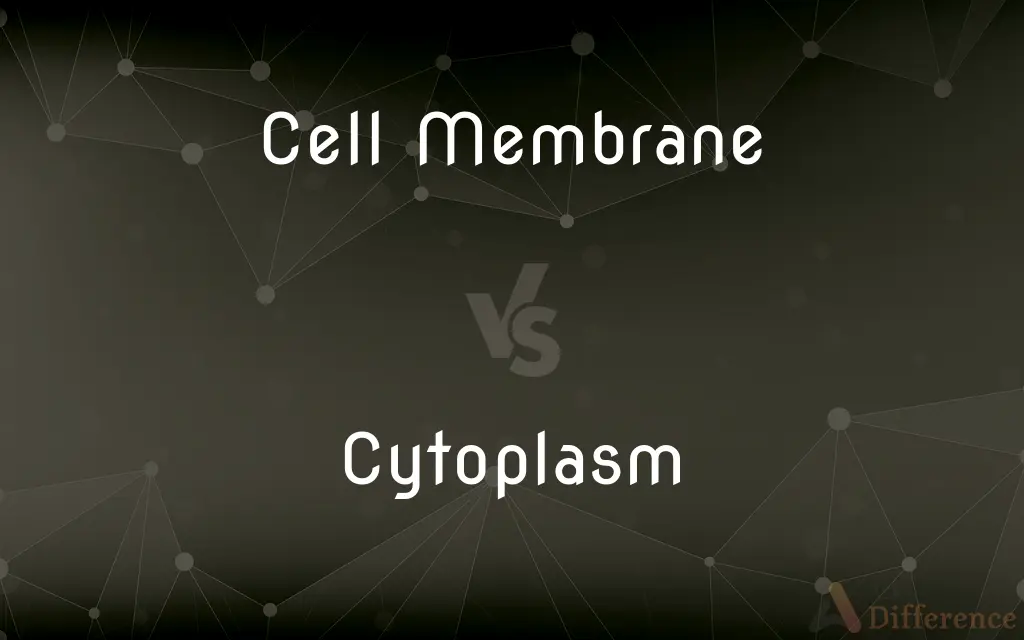Cell Membrane vs. Cytoplasm — What's the Difference?
By Tayyaba Rehman & Maham Liaqat — Published on June 16, 2024
The cell membrane encloses the cell's contents, controlling entry and exit, while cytoplasm hosts cellular processes within its fluid matrix.

Difference Between Cell Membrane and Cytoplasm
Table of Contents
ADVERTISEMENT
Key Differences
The cell membrane, a protective barrier, regulates substances entering and exiting the cell, ensuring homeostasis. On the other hand, the cytoplasm, a jelly-like substance inside the cell, contains organelles where most cellular activities occur.
The composition of the cell membrane includes a lipid bilayer with embedded proteins, providing structure and selective permeability. Whereas, cytoplasm comprises water, salts, and organic molecules, facilitating reactions and providing a medium for organelles.
Functionally, the cell membrane acts as a gatekeeper, maintaining the internal environment by selective transport. The cytoplasm, however, is the site for many metabolic processes, including glycolysis and protein synthesis.
In terms of interaction with the external environment, the cell membrane directly interfaces with extracellular substances through various mechanisms like diffusion and active transport. In contrast, the cytoplasm interacts indirectly, affected by changes the cell membrane allows.
Structurally, the cell membrane's integrity is crucial for cell survival, protecting cellular contents from the outside environment. The cytoplasm's structure, while less defined, is essential for maintaining cell shape and internal organization.
ADVERTISEMENT
Comparison Chart
Function
Regulates entry and exit of substances.
Site for cellular processes.
Composition
Lipid bilayer with proteins.
Water, salts, and organic molecules.
Role in Cell
Protective barrier, maintains homeostasis.
Provides medium for organelle function.
Interaction with Environment
Direct through selective permeability.
Indirect, influenced by membrane's actions.
Structural Importance
Essential for cell integrity.
Maintains cell shape, supports organelles.
Compare with Definitions
Cell Membrane
Signal Transduction
The cell membrane plays a key role in signal transduction, receiving and conveying signals.
Cytoplasm
Metabolic Processes Site
The cytoplasm is where glycolysis and other metabolic processes take place.
Cell Membrane
Protective Barrier
The cell membrane serves as a protective barrier, safeguarding the cell's internal environment.
Cytoplasm
Support and Structure
The cytoplasm helps maintain cellular structure and supports organelle distribution.
Cell Membrane
Interaction with Other Cells
The cell membrane facilitates interaction with other cells through cell adhesion molecules.
Cytoplasm
Medium for Organelles
The cytoplasm provides a medium for organelles to remain suspended and functional.
Cell Membrane
Selective Permeability
Through selective permeability, the cell membrane controls the passage of ions and molecules.
Cytoplasm
Jelly-like Substance
Composed of water, salts, and proteins, the cytoplasm has a jelly-like consistency.
Cell Membrane
Structural Support
The cell membrane provides structural support, maintaining the cell's shape.
Cytoplasm
Intracellular Transport
Materials are transported within the cytoplasm from one organelle to another.
Cytoplasm
The protoplasm enclosed by the plasma membrane of cell, excluding the nucleus in eukaryotic cells and cellular DNA in prokaryotic cells.
Cytoplasm
(cytology) The contents of a cell except for the nucleus. It includes cytosol, organelles, vesicles, and the cytoskeleton.
Cytoplasm
The substance of the body of a cell, as distinguished from the karyoplasma, or substance of the nucleus.
Cytoplasm
The protoplasm of a cell excluding the nucleus
Common Curiosities
What functions does the cytoplasm perform?
The cytoplasm hosts metabolic processes, supports organelles, and facilitates intracellular transport.
Why is the cell membrane crucial for cell survival?
It maintains homeostasis and protects the cell from external harm.
How does the cell membrane interact with its environment?
It interacts directly through selective permeability, allowing or denying passage of substances.
Can the composition of the cytoplasm change?
Yes, its composition can change depending on cellular activity and external conditions.
How does the cytoplasm affect cellular processes?
It provides the necessary environment for enzymatic reactions and organelle function.
Is the cytoplasm the same in all cells?
While universally present, its specific composition can vary between cell types.
What is the cell membrane made of?
The cell membrane is composed of a lipid bilayer with embedded proteins.
What role do proteins play in the cell membrane?
Proteins function in transport, signal reception, and structural support.
How do cell membrane defects affect health?
Defects can lead to diseases by disrupting cellular functions and communication.
What mechanisms do cell membranes use to transport substances?
Mechanisms include diffusion, osmosis, active transport, and endocytosis.
How does the cell membrane maintain homeostasis?
By regulating the passage of substances in and out of the cell.
Can the cytoplasm help in detoxifying substances?
Yes, enzymes in the cytoplasm can break down toxic substances.
How does the cell membrane facilitate cell communication?
Through receptors that receive signals and through connections with other cells.
Does the cytoplasm contain DNA?
In eukaryotes, DNA is primarily in the nucleus, but mitochondria and chloroplasts in the cytoplasm contain their own DNA.
What is the importance of water in the cytoplasm?
Water facilitates chemical reactions and provides a medium for organelles.
Share Your Discovery

Previous Comparison
Booging vs. Booking
Next Comparison
Prime Rib vs. Roast BeefAuthor Spotlight
Written by
Tayyaba RehmanTayyaba Rehman is a distinguished writer, currently serving as a primary contributor to askdifference.com. As a researcher in semantics and etymology, Tayyaba's passion for the complexity of languages and their distinctions has found a perfect home on the platform. Tayyaba delves into the intricacies of language, distinguishing between commonly confused words and phrases, thereby providing clarity for readers worldwide.
Co-written by
Maham Liaqat











































